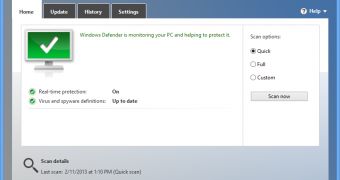Windows Defender is now a full-featured anti-virus product that’s installed by default in Windows 8 and is supposed to protect users’ computers from basically any form of malware.
And even though the Redmond-based technology giant has released quite a lot of improvements for its in-house security product, Windows Defender is far from becoming the top security product users need when going online with Windows 8.
The latest results unveiled by independent anti-virus research firm AV-Test indicate that Windows Defender fails to detect approximately 10 percent of the malware.
James Lyne, director of Technology Strategy, Sophos, told CNME that Microsoft must continue to improve Windows Defender and bring it in line with the other security products on the market.
“While Windows Defender has been making progress in detection and achieving some solid results, it doesn’t provide the full range of capabilities that businesses need and expect to fend off cyber criminals. Effective security today requires an approach of ‘defence in depth’ – that is putting in place a range of different controls layered together to achieve effective protection,” Lyne explained.
Nicolai Solling, director of Technology Services, Help AG, also believes that Windows Defender has shown some real progress, but more updates supposed to help the app detect a higher percentage of malware are still needed.
“Advanced-level endpoint security addresses user behaviour control, device management, corporate policy and network access control, which are all areas where Windows Defender has some progress yet to make,” he told the same source.
Microsoft, on the other hand, contested AV-Test’s results, stating that its in-house security software was actually much better than what the testing may lead people into believing.
In addition, the software giant performed its very own test to show everyone that its anti-virus solution manages to detect all samples of malware.
“When we did our review, we found that our customer-focused processes had already added signatures that protected against 4 percent of the missed samples. These files affected 0.003 percent of our customers,” Joe Blackbird, program manager, Microsoft Malware Protection Center, said in a statement.

 14 DAY TRIAL //
14 DAY TRIAL //